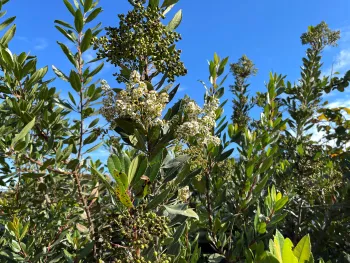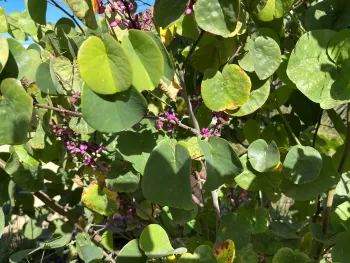
If strong winds are damaging your garden - breaking branches, pulling moisture from foliage, and drying out soil - why not consider planting a living windbreak?
A living windbreak is a group of plants positioned to filter the wind. The group can be as small as a few shrubs or as large as a group of trees, shrubs, and small plants that slow the wind. Benefits can include improving soil quality, conserving water, and creating a sheltered microclimate beneficial to wildlife.
When planning a windbreak, three important things to keep in mind are positioning plants to maximize their resistance to the wind, following the fire-smart guidelines for spacing plants, and choosing wind-resistant plants.
Position your plants to resist the wind

A windbreak is best positioned at right angles to the prevailing wind direction—in our area, this is usually north to northwest. Since it gets coolest in the winter on the north and northwest side of your home, planting in this area could even save you some money on heating.
The goal of a windbreak is not to block out all wind by planting in a dense, linear way. This, in fact, may lead to a fire hazard when the plants are fully grown. Instead, stagger the plants. And, if possible, plant several rows. This will temper the wind by allowing some air to pass through, thus reducing the intensity of the wind along the sides of the grouping.
Guidelines for spacing plants
It is recommended that windbreaks be planted thirty feet or more from your house or any structure. Calculate the size—how tall and how wide—that plants will be at maturity and give them plenty of growing space. Be aware of other safety rules, such as not planting a small bush directly under a tree, which might lead to a fire ladder. For more fire-smart guidelines, see the UC Marin Master Gardener website: marinmg.ucanr.edu/BASICS/FIRESMARTLANDSCAPING/Plan/#spacing

Choose wind-resistant plants
Plants that are multi-stemmed, with small leaves that can bend in the wind, offer the most wind resistance. Many of our native plants are in this category and many are also drought tolerant.
There are several native evergreen shrubs, for example, that make excellent windbreaks. The Pacific wax myrtle (Myrica californica) is one of my favorites. I have found the bush extremely easy to grow, although I did lose a couple to gophers. Now, I plant them inside gopher baskets. This native may need more water to get established. Grows to five to over thirty feet tall. Deer tolerant.
Another native shrub is the coffeeberry (Frangula californica). It grows five to fifteen feet tall with a ten-foot spread, or you can buy a dwarf size. It attracts a variety of birds with its dark red berries in the winter. Deer tolerant.

If you have room for taller tree-like shrubs, the toyon (Heteromeles arbutifolia) is a beautiful evergreen with red berries in winter. The Western Redbud (Cercis occidentalis) is another with vivid pink blooms and memorable heart-shaped leaves that are deciduous in winter. Both are deer-resistant once established.
Try to include a variety of plants in your windbreak. Many beneficial insects need nectar year-round, and you can help them with plants that bloom at various times of the year: California lilac (Ceanothus) flowers in spring, sage (Salvia) in summer, California fuchsia (Epilobium canum) in fall, and manzanita (Arctostaphylos) in winter. These plants come in a variety of sizes depending on the cultivar.
Winds can be fierce in winter and spring. A living windbreak can tame the wind while also benefiting soil and wildlife. Just remember to choose wind-resistant plants, position them at the right angle to the wind, and space them wisely for fire safety.
For more information, see the UC Marin Master Gardener website: https://marinmg.ucanr.edu/
By Pamela Noensie, April 12, 2025

